Visiting
Grandfather and Grandmother Church in Petersburgh
......
by Jean
Bierwirth Bornt
When I was growing
up I spent many happy hours at Grandmother and Grandfather Church's
at their house by the river in Petersburgh NY. During summer vacations
from school I would stay there for weeks at time. All of their many
grandchildren were welcome to spend as much time as they wished
at their "home away from home."
Now
I should remark from the start that I'm not just being pretentious
or trying to be formal in my writing when I call my grandparents
"Grandfather" and "Grandmother," not "Grandpa"
or "Nana" like some of the kids do now. All of us grandchildren
actually DID address them in this fashion and still talk about them
as "Grandmother and Grandfather" even to this day.
I remember Grandfather had a side porch on the river side where
he would take his nap in the porch swing. He had a rope attached
to a porch post and would rock himself to sleep. The sound of the
river gurgling over the rock ledges was a beautiful lullaby for
an afternoon snooze.
Inside the door
from the porch was their living room. They had an old roll-top couch
which Grandmother covered with a spread she had crocheted from long
torn strips of colorful cloth she had sewn end-to-end. Grandfather
hand-carved her the smooth wooden crochet hook that she used for
crocheting. The back of the couch was lined with brightly-colored
pillows assembled from pieces of saved materials.
Grandmother's
creativity was evident in everything she did, and especially in
making pretty things out of the scraps and leftovers from past projects.
She was a born decorator who used her Yankee ingenuity to make up
for the things she never had and couldn't afford.
Continuing on
with my tour of their house - in the dining room I recall a round
oak table with claw feet, with a matching sideboard. It had an ornate
shelf, a marble top with drawers and doors galore. Here was where
Grandmother kept all her treasures.
I loved to rummage
through these drawers, and poke and examine all the wonderful items
she had  saved.
One treasure that she gave me and I still have is the postcard dated
December 1, 1924 that Mom and Dad, Esther and Otto Bierwirth, had
sent them while on their honeymoon in Boston. (see card at right) saved.
One treasure that she gave me and I still have is the postcard dated
December 1, 1924 that Mom and Dad, Esther and Otto Bierwirth, had
sent them while on their honeymoon in Boston. (see card at right)
Off the dining
room was a storage room that Grandmother made over into a "summer"
kitchen. She single-handedly painted and papered the walls and laid
a sheet of linoleum on the old floor. After moving in a cupboard
and an oil stove, now, in these long-ago days before Home Depot
ceiling fans and Trane air conditioning, she had a place to cook
during the hot humid days of June, July, and August.
Without cooking
in the kitchen of the main part of the house, the place would stay
relatively cool without air-conditioning. Grandmother would close
the windows early in the morning, and without the sun coming in
it was quite comfortable.
It didn't matter
how many folks dropped in unexpectably around mealtime. Grandmother
would see to it that no one went away hungry. Down in the cellar
was a store of home-canned meat, vegetables, and fruit that she
would draw upon to whip up an elegant meal fit for a king. I think
there was a good reason why some of those folks showed up around
mealtime, especially in the lean times of the Great Depression!
In a dining alcove off the main kitchen was another circular oak
table, and during the fall and winter, both Grandfather and Grandmother
cooked on a cast-iron wood stove. Here's where their famous "water"
johnny cake would come straight out of the oven onto the round table,
where it would be slapped with a dollop of yellow butter to ooze
down into the cornbread just seconds before being instantly devoured
by a hungry child who had been playing outdoors all day by the river.
Unfortunately, the recipe to reproduce that wonderful taste has
never been exactly duplicated.
Here also was
the source of the "boiled dinners," stewed in an iron
kettle over the wood stove's blackened griddles. It started with
ham or salt pork cooked 'til 'almost' done; then the cabbage, potatoes,
carrots, onions, and sometimes turnips and beets would be added
along with a little cayenne pepper.
Grandmother
also made yeast rolls that were light and fluffy with a brown crust
on the top and bottom, (see her recipe at right) and were fondly
known as "Grandmother's Rolls." She made and sold them
to many of the neighbors. I have the recipe directly from her because
when I was first married she came to my house and directed how to
make them step-by-step. (See recipes above.)
Another of everyone's
favorites from her kitchen was her baked beans. She always brought
this "covered dish" to all the family picnics, reunions
and parties, or "infairs" as Grandfather called them.
All the picnic-goers made sure they got second helpings of "Myrt's
Beans" (recipe above.)
Did food taste
better back then or do one's taste buds dull with age?
The old round
oak table could tell some fascinating tales of the Saturday night
card games of "pitch" as Grandfather and his cronies gathered
around it for an evening's diversion. They took their cards seriously,
even though they were only playing for "points," and their
language was more than a little emphatic as they slapped their cards
down onto the table with cries of triumph or disgust!
Grandfather
also had an yellowed and faded Chinese checker board with its colored
marbles set up on a small tray table, ready for challengers to his
prowess at any time of day. Grandmother loved working on picture
puzzles, and always had one in progress on a card table in the parlor.
And in those days before collages were widely known as an art form,
Grandmother had a wall collage composed of photographs of her children
and grandchildren.
The old house
originally had been the town's blacksmith shop when they purchased
it about 1913. In time Grandfather converted the upstairs into three
bedrooms with a bathroom, as they were able to afford materials
and furnishings. In their bedroom Grandmother needed a "clothes
press," or closet, so she built one out of cardboard and curtains
which served its purpose just fine.
The old house
originally had been the town's blacksmith shop when they purchased
it about 1913. In time Grandfather converted the upstairs into three
bedrooms with a bathroom, as they were able to afford materials
and furnishings. In their bedroom Grandmother needed a "clothes
press," or closet, so she built one out of cardboard and curtains
which served its purpose just fine.
Across the hall
the largest bedroom had another depository of treasures - a chest
of drawers where Aunt Harriet kept all her school mementoes. Grandmother
allowed me to rummage through this fascinating collection whenever
I showed up as a guest.
Grandfather's
Pomeranian pup "Prince," which he fondly nicknamed "Printer,"
was given orders in the late  mornings
before noon to awaken all the sleepy heads who were staying over
at the time. He would send Printer up to get us up for breakfast.
Up the stairs Printer would bound, jump onto the bed, and lick us
in the face until we arose to tumble down to "brunch." mornings
before noon to awaken all the sleepy heads who were staying over
at the time. He would send Printer up to get us up for breakfast.
Up the stairs Printer would bound, jump onto the bed, and lick us
in the face until we arose to tumble down to "brunch."
Grandmother
belonged to the Home Bureau, part of the county extension service
which encouraged and promoted useful do-it-yourself home projects
out in the rural areas. It also gave the housewives an outlet for
socializing outside their homes while working on their projects.
Grandmother made many lovely and fancy hats while she was a member,
which she wore whenever it was sunny. Perhaps that is why she had
such a youthful and wrinkle-free complexion even into her seventies.
Once she took
me to a "quilting bee" at the Methodist Church hall. The
ladies let me help with the quilting stitches, which was a big thrill
for a young girl. All the ladies had brought a dessert and during
the rest period we had all these home-made goodies with coffee,
tea, and lemonade. When the quilt was finished it was raffled off,
the proceeds going to the church. The lucky winner received a unique
handcrafted item, a real historical and sentimental treasure.
Every spring
after the danger of frost was considered to be past, Grandfather
and Grandmother planted a garden on the river bottom land behind
Uncle Jay's house. (See the photo of Uncle Jay's garden on the "Under
the Bridge" page.) As the river meandered back and forth
in the channel that it had cut through the ancient bedrock, it deposited
a sandy loam that produced bountiful crops.
As the summer
progressed they spent many hours there hoeing and weeding in the
morning before the heat of the day. By middle August and early September
it was time to harvest the crops. Grandfather called harvest time
"The Green Corn Dance." Besides tomatoes and carrots and
corn and squash, they raised cranberry beans, a red and white striped
variety.
When the beans
were dried enough to shell, they brought them to the kitchen along
with fresh picked sweet corn. Grandmother cut the corn from the
cob, shelled the beans, and combined them in a large kettle with
water to cook. After the potpurri was done, she added milk, butter,
salt, pepper, and heated it to make this "succotash,"
a dish with roots in Indian lore. Served with the aforementioned
"water johnnycake" it was, I think, their most delicious
and memorable treat.
|
|
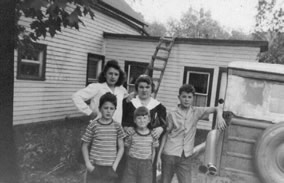
Here we are
at Grandmother's with her "summer" kitchen in the background,
about 1937 or '38: Me (Jean), my mother Esther, and my younger
brothers in front - Tommy, Johnny, & Jimmy (I didn't really
tower over my mother like that - since I am so short I must have
been standing on a box!)
Grandmother's
Rolls or Bread
(Grandmother
Myrtle Church's original family recipe)
2
cups milk
1/2 cup sugar
1 teaspoon salt
1 tablespoon butter
Rolls:
Heat together - Bring to a boil, but do not boil. Let cool.
1 yeast cake dissolved in 1 cup lukewarm water. Stir in 7 cups
flour. Use 1/2 cup to mold to put in bowl. Grease bowl. Cover
until raised to top. Punch and roll out. Cut off in pieces. Shape
into balls. Let raise again. Bake in 350° until done. Take
out of oven; Brush with butter immediately.
Method
for bread: Let yeast soak until milk is cool. Put milk in
mixing bowl with dissolved yeast. Add flour gradually and mix
until all flour is in. Knead on floured board until smooth. Put
in greased bowl and cover with greased cover. Let rise until dough
comes to top of bowl. Divide in half and shape. Put in greased
bread tins, bake.
"Myrt's
Beans"
Soak large
package of navy or great northern beans overnight, completely
covered with water. Add more as needed.
In the morning
slice salt pork into strips and boil for 20 min. in water. Add
drained beans and add water to cover.
Add a little
crushed red pepper flakes, 1/2 cup sugar. Salt and black pepper
to taste.
Cook covered
until tender. Pour into a baking pan and sprinkle brown sugar.
Aunt
Harriet Willetts' Chili Sauce
(given
to Aunt Harriet by Vivian White,
a very old recipe)
12
tomatoes (peeled and blended)
3 onions (ground)
3 green peppers (ground)
1-1/4 cups of sugar
1 tablespoon salt
3/4 teaspoon cinnamon
1/2 teaspoon ground cloves
1/2 cup vinegar
Cook 2 hours or more
Add some crushed red pepper to taste
Put in sterilized jars and seal
Makes about six pints
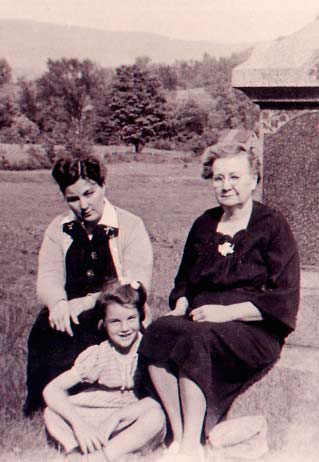
Floss McCumber,
Grandmother, and granddaughter Susie McCumber (photo courtesy
of Kathy McCumber Armstrong)
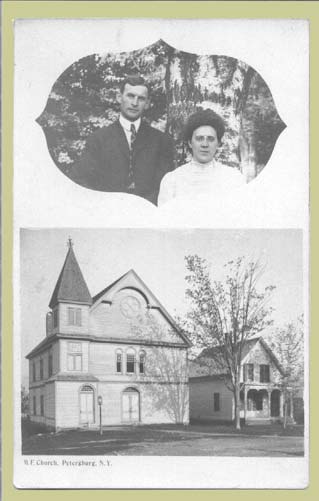
Rev. and Mrs. David Paton, (above) pastor of the Petersburg Methodist
Church; Parsonage shown on right (south) side of church
Otto Bierwirth and Esther Church were married here November 31,
1924 by Rev. Paton
MALDEN'S
MEMORIES
Reprinted from The Eastwick Press, July 5, 2002, p. 23
C. Malden
Wells was born in Petersburgh on August 4, 1907. He grew up in
the "mill yard" (Wells complex). He lives now in Watervliet.
Homemade
Drinks Circa 1930
Now
this is a true story; a lemonade story.
Rev.
David Paton was assigned to the Petersburgh Methodist church in
the 1920's. I was in Nichols Store on a Sunday when Rev. Paton
and his wife stopped. there. Mrs. Paton told Mr. Nichols that
she was so glad the store was open because she needed some lemons.
The Reverend said, at once, that they could not encourage Fred
to be open on Sunday, so he added, they could buy on Sunday. Our
church agrees, and so do I, he added. She responded that she was
hosting the Ladies Aid Society later in the day and she already
told the ladies to come for she was serving lemonade. I think
she wore the pants in the family, or maybe she was just an excellent
salesperson. In any case the Reverend told her to go in and ask
if you can get the lemons today and pay for them on Monday.
Perhaps
times haven't changed that much. Recently a clergyman called my
niece to babysit on his Sabbath. Then he asked her if she could
come back later to get paid. - C. Malden Wells
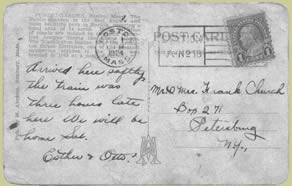
Otto and
Esther's honeymoon postcard back home to Grandfather and Grandmother,
postmarked Boston, Mass., Dec. 1, 1924
The "Ford"
coil, cause of the cussin'!
One Sunday
morning after services outside the Methodist Church, Otto, always
the practical joker, had hooked up a "Ford" coil on
a switch and wired it to his car doorhandle. Calling over a church
lady to his car, she leaned on the door, and he threw the switch.
An arc of electricity jolted her backwards.
"You
S.O.B.!" she screamed, then realized her location and covered
her mouth. "Look what you've made me do, now! You've made
me swear in the church yard!"
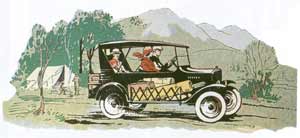
|
|  In
the 1940's after World War II was over, a fad of making "granny"
afghans swept the country among the ladies who enjoyed handcrafting.
Those who could afford it purchased new wool yarn (acrylics weren't
invented yet). In
the 1940's after World War II was over, a fad of making "granny"
afghans swept the country among the ladies who enjoyed handcrafting.
Those who could afford it purchased new wool yarn (acrylics weren't
invented yet).
Grandmother,
thrifty and inventive as always, let it be known amongst the family
that she was going to make one with discarded wool sweaters. Every
one pitched in and gave her their old used stretched-out sweaters,
(some khaki ones from the Army boys, too). After she had been given
enough of them for the project, she washed them all, and then began
the tedious process of preparing her "yarn" for the afghan.
First she laborously
unraveled all the sweaters. Then she balled the yarn and divided
it into its various colors. It took a while, but eventually from
these discards she crocheted a beautiful "granny" afghan
coverlet.
And these were
some of my happy, serene childhood days in the 1930's visiting my
grandparents Frank and Myrtle Church on the banks of the Little
Hoosic River.
- Jean Bierwirth
Bornt, July 2002
Ed. Note:
Mrs. Jean Bierwirth Bornt is a member of the National Society of
the Daughters of the Revolution, Reference Number 820016.
(Above)
Delphinum (one of Grandmother's flowers...also, see the "Church
Begonia" and "Jean's
'Pinks' ")
 Visit our new online store at http://johnnycakehill.tripod.com
Visit our new online store at http://johnnycakehill.tripod.com
If you enjoy your Churchtree
site, please help us defray expenses of research and maintaining
our site.
Click on the farm scene above and your Pay-Pal donation of any amount, $5, $10,
$25 or more will be
greatly appreciated, and if you wish, your name will be included on our donor
page. Thanks for
supporting the Church Family of Petersburgh NY website!
|
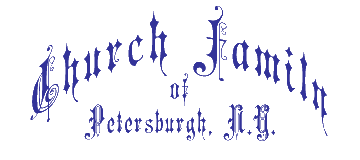


 saved.
One treasure that she gave me and I still have is the postcard dated
December 1, 1924 that Mom and Dad, Esther and Otto Bierwirth, had
sent them while on their honeymoon in Boston. (see card at right)
saved.
One treasure that she gave me and I still have is the postcard dated
December 1, 1924 that Mom and Dad, Esther and Otto Bierwirth, had
sent them while on their honeymoon in Boston. (see card at right) mornings
before noon to awaken all the sleepy heads who were staying over
at the time. He would send Printer up to get us up for breakfast.
Up the stairs Printer would bound, jump onto the bed, and lick us
in the face until we arose to tumble down to "brunch."
mornings
before noon to awaken all the sleepy heads who were staying over
at the time. He would send Printer up to get us up for breakfast.
Up the stairs Printer would bound, jump onto the bed, and lick us
in the face until we arose to tumble down to "brunch."




 In
the 1940's after World War II was over, a fad of making "granny"
afghans swept the country among the ladies who enjoyed handcrafting.
Those who could afford it purchased new wool yarn (acrylics weren't
invented yet).
In
the 1940's after World War II was over, a fad of making "granny"
afghans swept the country among the ladies who enjoyed handcrafting.
Those who could afford it purchased new wool yarn (acrylics weren't
invented yet). 